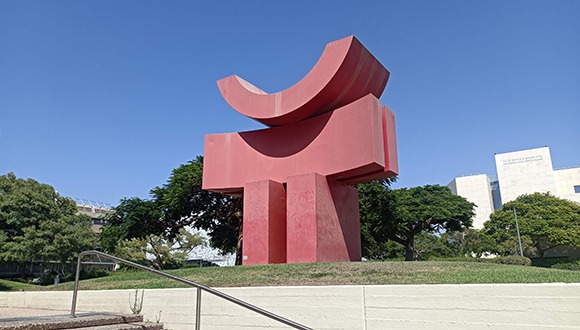2MS Series No. 4 | Bernard Schottlander
The red sculpture 2M Series no. 4 represents a body with two straight, parallel legs and two pairs of convex arms, which carry a head shaped as a half-circle open to the sky.
About the Work and the Creator / Sivan Langer and Miri Attia-Auerbach
Bernard Schottlander (1924-1999) was born in Meinz to a Jewish family. After the events of Crystal Night in 1938, he escaped to England. He began his career as a welder and caster while studying at the Leeds School of Arts. Following his military service, he studied industrial design in London. Later on, he taught welding and metalworking at Central Saint Martins, and was closely affiliated with the metal sculptors who worked there. Only in the late 1960s did he begin concentrating on sculpture alone. Schottlander's sculptures are extremely large, and have a monumental quality. They may be seen as the ultimate form of urban sculpture, since their size, clear-cut forms, mass and bold colors fully exploit the exposure given to them in the public sphere.
Like many of his sculptures, the two sculptures on the Tel Aviv University campus are highly symmetrical, calculated and precise. They are both composed of geometric forms and their clear-cut, angular execution speaks the language of industrial architecture. Schottlander uses industrial metal to create stable, streamlined structures that are uniformly painted in bold colors. The large dimensions and monochromatic quality of each sculpture allow it to be easily perceived even by a distant, mobile viewer; in addition, these works dramatically exploit the effect of the sun by creating sharp shadows, which change throughout the day. One side of the sculpture gleams to the point of appearing flat, while the other is cast into shadow. It seems that Schottlander uses streamlined forms in order to entertain a clearly articulated dialogue with every viewer.

Material, Color, and Minimalist Influence
The sculptures' bold palette conceals the material they are composed of. The black and red colors stand out against the buildings and the green lawn, declaring themselves to be artificial industrial products. The iron elements are designed to resemble beams or walls, and the intersections between them create volume and imprison additional spaces. Schottlander was active at the same time as the Minimalist movement. Like the Minimalist works, his sculptures are shaped by abstract elements, industrial processing and a combination of precise geometric volumes. The art critic Dennis Brown, however, saw his work as distinct from Minimalism due to its focus on symmetrical structures anchored in a monolithic symbolism, rather than defining entities in space.1 Indeed, his sculptures clearly allude to the human
figure.
In addition to its anthropomorphic qualities, the sculpture 2M Series no.4 calls to mind Brancusi's Endless Column (1937) in terms of its height, its upward thrust and its spiritual resonance. Yet it seems that Schottlander's spiritual intentions are expressed not so much in terms of the sculptures' height, but rather in terms of the similar manner in which they are truncated. The red sculpture 2M Series no. 4 represents a body with two straight, parallel legs and two pairs of convex arms, which carry a head shaped as a half-circle open to the sky. The sculpture 2MS Series no. 4 similarly culminates in a truncated triangle open to the sky. These open spaces at the top of each sculpture stand out in contrast to their significant mass.
Symbolism and Jewish Context
The combination of tremendous height, a human form and a head that opens upwards like a receptacle and transmitter, points towards numerous metaphysical interpretations. Depending on their personal and cultural associations, viewers may detect in the sculpture a human longing for divine wisdom, mercy, inspiration or help. Like Brancusi's ladder-column, which serves as a spiritual tool for transcendence, Schottlander seems to create a human receptacle for divine love and mercy, which can contain them and broadcast them down to earth. In Series 2MS no. 4, one may also identify two letters of the Hebrew alphabet positioned one atop the other, attesting to Jewish symbolism.
The sculptures' monochromatic quality, and the connection between their geometric components, are reminiscent of the works created by the highly influential British sculptor Anthony Caro - abstract steel sculptures painted the same light-colored shade and positioned directly on the ground, without a pedestal. Schottlander, who was closely affiliated with Caro, was no doubt influenced by him. Nevertheless, his sculptures are not horizontal like Caro's, but rather vertical. In the red sculpture, one may note a lack of continuity between the frontal and side views of the work; the theme of this sculpture, however, is the human soul and its longing for the sublime. This theme parallels the anthropomorphic shift evident in the works of the American sculptor David Smith. Yet in contrast to Smith's Cubi sculptures, Schottlander's formal language -which also makes use of various combinations of cubes - is more symmetrical and mathematical.
His on-campus sculptures have stable legs, and develop in a calculated and balanced manner. In contrast to Smith's series, which each include a range of organic forms similar to those in nature, each of Schottlander's monumental sculptures present their unified internal logic in a unique and immediate manner. Smith does not conceal the qualities of the material by painting his sculptures, and stamps them with the imprint of his hands. Schottlander, by contrast, ascribes great importance to the armorlike surface of his works, which he underscores by painting them uniformly - creating universal signs of a seemingly mathematical, linguistic system.
| Artist: | |
| Bernard Schottlander | |
| Name: | |
| 2M Series no.4, 1972 | |
| Location: | |
| Bronja and Juma Mandel Square, in front of the Law Faculty building | |
| Donated by Dr. Arthur M. Sackler, Dr. Mortimer D. Sackler and Dr. Raymond R. Sackler |





